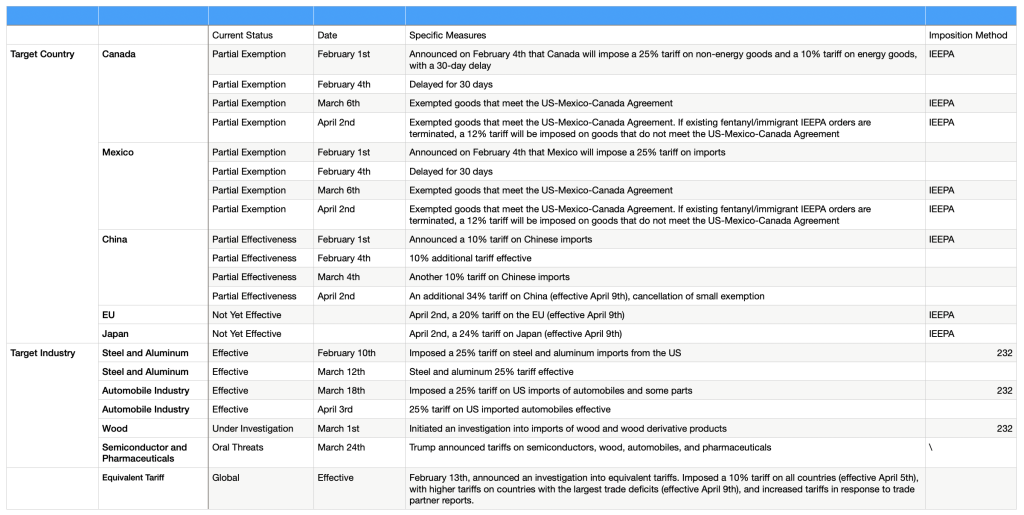Recent months have seen a sharp escalation in global trade tensions as the United States rolled out a series of tariff hikes targeting multiple trade partners. A detailed chart outlining these measures reveals a pattern of protectionist actions across industries such as energy, steel, aluminum, and automobiles.


Tariffs on Canadian Energy and Goods
Starting February 1, the U.S. imposed a 25% tariff on non-energy goods and a 10% tariff on energy-related imports from Canada. Initially scheduled for February 4, these measures were delayed by 30 days. By March 6, exemptions were granted to Canadian goods compliant with the U.S.-Mexico-Canada Agreement (USMCA). However, on April 2, the U.S. warned of imposing a 12% tariff on non-compliant Canadian goods if unresolved issues related to fentanyl trafficking and immigration persist.
Mexico Faces Similar Pressure
Parallel measures were announced for Mexican imports, with a planned 25% tariff on February 4, also postponed by 30 days. USMCA-compliant goods were exempted on March 6. The April 2 warning echoed the Canadian scenario: a 12% tariff on non-compliant Mexican goods unless fentanyl and immigration concerns are addressed.
Dual Tariff Waves Targeting China
The U.S. introduced an initial 10% tariff on Chinese goods, originally set for February 4 but later split into two batches on February 4 and March 4. On April 2, an additional 34% tariff was announced, effective April 9, alongside the elimination of exemptions for small-value shipments.
Pending Tariffs on EU and Japan
Measures against the EU and Japan remain pending. On April 2, the U.S. outlined plans to impose a 20% tariff on EU goods and a 24% tariff on Japanese imports, both set to take effect on April 9.
Sector-Specific Tariffs: Steel, Aluminum, and Automobiles
A 25% tariff on steel and aluminum imports was announced on February 10, taking effect March 12. On March 18, a 25% tariff on automobiles and select components followed, formalized on April 3.
Threats to Expand Tariffs
The U.S. has initiated investigations into lumber imports, signaling potential tariffs on wood and related products. President Trump has also verbally threatened tariffs on semiconductors, automobiles, and pharmaceuticals.
Secondary and Retaliatory Tariffs
The U.S. further imposed a 25% secondary tariff on countries importing oil from Venezuela, conditional on their imports of U.S. goods.
As global trade dynamics grow increasingly volatile, nations are urged to prioritize dialogue and seek mutually beneficial solutions to stabilize the international economic landscape.







